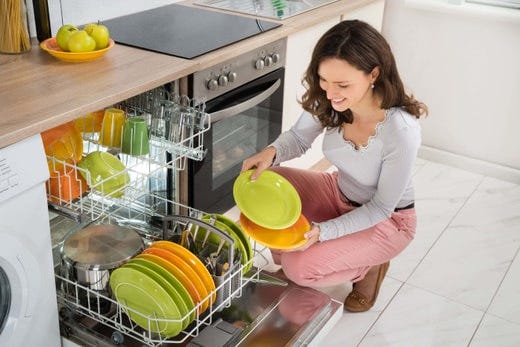
How to Avoid Water Spots on Dishes with Ease

Whether you are a seasoned dishwasher user or have just started using one, you must have noticed water spots or a cloudy film on your dishes after they come out.
Unfortunately, these water spots can cause build-up and be hard to remove by hand, taking additional time. Well, there is no need to panic!
Read our article about how to avoid water spots on dishes for some easy steps to ensure your dishware is always spotless, clean, and in pristine condition.
What are water spots?
Water spots on dishes occur due to the minerals in hard water stains in the dishwasher, which are left behind when the water evaporates during the dishing cycle.
These minerals, primarily calcium and magnesium, can cause residue on the glassware, resulting in unwanted spots or streaks.
While water spots are not dangerous, they can be caused by several factors, including hard water, too much detergent, or lack of Rinse Aid.
Methods of preventing water spots?
Identifying the problem and making the necessary adjustments can help you prevent your dishes from getting water spots. Follow these useful suggestions to ensure your dishes are sparkling clean and shining.
1. Reducing detergent consumption:
Using less detergent in the dishwasher can effectively prevent water spots on dishes by reducing the residue left behind during the cleaning process.
Excessive detergent can build up residue on the dishes and further interact with minerals in hard water, leaving spots on the dishes.
Using the correct amount of detergent is not only the right way to use it but also minimizes the risk, provides thorough cleaning, maintains the dishwasher’s functionality, and enhances your tableware's overall appearance and shine.
Using rinse aid can be mentioned here as a point and please hyperlink to Finish Salt.
2. Addressing hard water challenges:
Install a water softener. This device helps eliminate hard water by removing minerals like calcium and magnesium through an ion exchange.
In this process, resin beads in the softener attract and trap these minerals, replacing them with sodium ions. Softer water is less likely to cause mineral buildup on dish surfaces.
You can also use Finish Dishwasher Salt, which effectively softens water to prevent residue marks from hard water on glasses and dishes and prevent limescale buildup.
In addition, there are several other benefits of dishwasher salt that you can learn about in our why should you use dishwasher salt.
3. Adding rinse aid:
Rinse Aid reduces the surface tension in water during the rinse cycle, allowing it to spread and form thinner sheets than droplets. This allows water to flow off dishes more easily, preventing droplets from clinging and leaving behind spots as the water evaporates.
Rinse aid also helps dishes dry faster and more evenly, minimizing the chances of water spots forming. This results in sparkling, spot-free dishes after each wash.
What are the benefits of using rinse aid?
In addition to preventing water spots, Finish Rinse Aid offers multiple other benefits:
- Speeds-up drying helps dishes to dry faster and more effectively.
- Rinses residue, leaving dishes and glassware sparkling clean.
- Protects against scratches, preserving their appearance.
- Prevents dirty stains and food residues from sticking to dishes, ensuring a thorough clean.
How do you use a rinse aid to remove water spots in dishwashing?
Rinse Aid can be put alongside the dishwashing detergent in the dishwashing compartment, and cleaning the glasses and other kitchen utensils in your dishwasher will tackle all the water spots and film that come with hard water stains.
Follow the steps below to learn how to use Rinse Aid in your dishwasher:
- First, look for the built-in liquid rinse aid dispenser alongside the detergent cups.
- Now, fill the dispenser with a Finish Rinse Aid and clean up any spills.
- The dishwasher will release the product in every wash cycle, leaving your dishes sparkling clean.
- Keep the detergent chamber full with Finish Rinse Aid. Meanwhile, keep an eye out for a top-up every month or whenever you get a red light signal of a low rinse aid level.
.png?width=70&height=45&format=png&quality=50)
